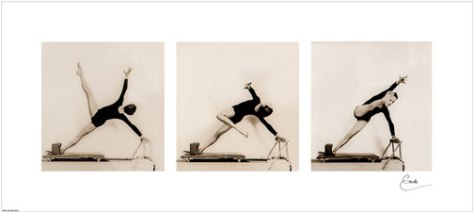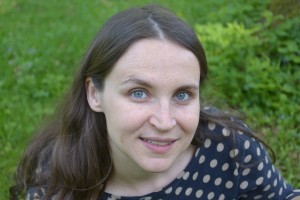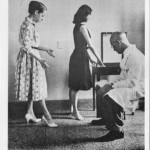A Strong WomAn: Carola Strauss-Trier
by Eva Rincke
Carola Strauss-Trier was the first person to open a Pilates studio – other than Joseph Pilates himself. She contributed significantly to establishing the Pilates method in the field of rehabilitation. The story of her life is just as interesting as the life of Joseph Pilates – but it contains so much suffering and terror that it’s not easy to handle. She was unable to finish her memoirs, because so many of her memories were too painful for her to bear it, yet she survived and lived her life and accomplished great things!
Carola was born in 1913 in Frankfurt, Germany. Her father was Eduard Strauß, a professor of chemistry who also taught comparative religious sciences at Jüdisches Lehrhaus, a Jewish open university in Frankfurt. Carola grew up in an inspiring intellectual environment – Martin Buber and Franz Rosenzweig were close friends of the family. She pursued an artistic career and started studying dance at Folkwang school in Essen.
In 1933, shortly before her 20th birthday, the Nazis came to power in Germany. Most dancers supported this “movement” hoping for renewal and new glory for the German nation. Being Jewish, this was a tragedy for Carola. During the first two years of Nazi regime, she scratched out a living by dancing for small entertainment shows and tried most of all not to attract any attention. In 1935, she couldn’t bear it anymore and went to France. Without documents, she supported herself as a dancer in nightclubs. Looking for a new career option, she became interested in acrobatics. This was how she met Marcel Naydorf, an acrobatics teacher. They fell in love. She developed her own show, dancing on roller-skates. The show was successful and her life seemed to stabilize.
Then World War Two started. The German Wehrmacht invaded France and Carola was interned by the French. From their point of view, she was a German, an enemy alien. That she had fled the Nazis didn’t count. From Paris, she was sent to the Gurs internment camp. Marcel Naydorf followed her. He was able to supply her with additional food and finally managed to have her released.

The following years were full of anxiety. Carola and Marcel settled in the so-called zone libre (“free zone”), the part of France that had not yet been occupied. She waited in despair for a visa to allow her to travel to the United States. In June, 1942, she finally received it. She was rescued at the last moment as shortly after she set off on the complicated trip via Algeria and Casablanca to the United States, the “free zone” was raided. Several thousand Jews were detained and most of them were sent to Auschwitz.
Carola had escaped. But upon her arrival in the United States, she was interned once again in Fort Howard, near Baltimore. She was once more regarded as a potential enemy alien, until her status as a refugee had been confirmed. Now she was finally able to start a new life – trying to get over that fact that she had had to leave behind her partner who had not received a visa for the US.
Very soon, Carola was back on stage with her skating show – her roller-skates were among the few things she had taken with her on her journey from Europe. In 1944, she had an accident on stage. Dr. Henry Jordan, the specialist for orthopedics who treated her at Lenox Hill Hospital, suggested that she should go to Joseph Pilates’ studio for rehabilitation. He was a client himself.
Meeting Joe Pilates for the first time was probably difficult for Carola. After her experiences with the Nazis, she certainly wouldn’t have picked a man like Joe with his strong German accent for her rehabilitation. But she trusted her doctor and took it on. She was thrilled! She was fascinated by the efficiency of the Pilates method. She realized that Joseph Pilates had developed an ingenious method for the rehabilitation of dancers. After she had successfully finished her own rehabilitation, she stayed on as a permanent guest of the Pilates studio and observed Joseph Pilates closely, especially when he was working with rehabilitation patients.
Carola also educated herself further regarding the medical side. Dr. Henry Jordan allowed her to observe him treating rehabilitation patients, even during operations, and she started working more closely with him. Towards the end of the Fifties, after she had been studying with Joseph Pilates for more than ten years, she decided to open her own studio. In the meantime she had married Edgar Trier, so she opened her studio as Carola S. Trier.
Her studio was located on 58th street in New York City, just two blocks away from Joe and Clara’s studio on Eighth Avenue. Her collaboration with Dr. Henry Jordan and Dr. William Liebler from Lenox Hill Hospital and her connections to show business brought her many clients from the world of dance. Her firmly-managed, up-to-date studio was different from the original.
Carola Trier’s studio was modern and rather minimalistic while many clients felt like they had gone on a journey back in time when they entered Joe’s studio. On Eighth Avenue, every client was required to take care of his or her own workout – in Carola’s studio you worked one on one. Carola and her assistants prepared the apparatus, gave instructions and feedback. The studio was doing so well that Carola hired several assistants, including some Pilates “big names” like Romana Kryzanowska and Kathy Grant.
Despite these differences, Carola and Joe Pilates resembled each other in many ways: she seemed severe and had an explosive temper; she didn’t like it if people were talking a lot in her studio; and she spoke English with a strong German accent all her life. Another similarity between the two was their wish to present their work to the public. Carola Trier was doing a successful job regarding public relations. In 1961, Dance Magazine published two articles about her work with dancers. In 1963, she managed to have some of her exercises promoted by Newsweek and Vogue.
In these glossy magazines, she presented exercises she had developed herself, so she didn’t see any necessity to mention her connection with Joseph Pilates. He didn’t like that and their relationship cooled during the years prior to his death.
From today’s perspective, it seems clear that Joseph Pilates and his method have benefited immensely by Carola Trier’s work. She ran her New York studio successfully until she retired in 1986. Her work in the realm of rehabilitation was the groundwork for the Pilates method to be used in that area. Today, the method is established in rehabilitation worldwide and its benefits have been proved by many scientific studies. Carola Trier trained many Pilates teachers, among them some of the most influential master teachers of today’s Pilates world: Lolita San Miguel, Alan Herdman, Deborah Lessen, Jillian Hessel and many more. She’s the role model for a path many dancers pursue following their active dancing career: they become Pilates teachers!
 Eva Rincke was born in Leonberg near Stuttgart, Germany, in 1981. She went to Humboldt-Universität, Berlin, where she got her master of arts degree in history and philosophy. Between 2007 and 2010, Eva worked at Buchenwald memorial, preparing an exhibition on Forced Labour. She started writing a novel inspired by her work and received several writing scholarships.
Eva Rincke was born in Leonberg near Stuttgart, Germany, in 1981. She went to Humboldt-Universität, Berlin, where she got her master of arts degree in history and philosophy. Between 2007 and 2010, Eva worked at Buchenwald memorial, preparing an exhibition on Forced Labour. She started writing a novel inspired by her work and received several writing scholarships.

